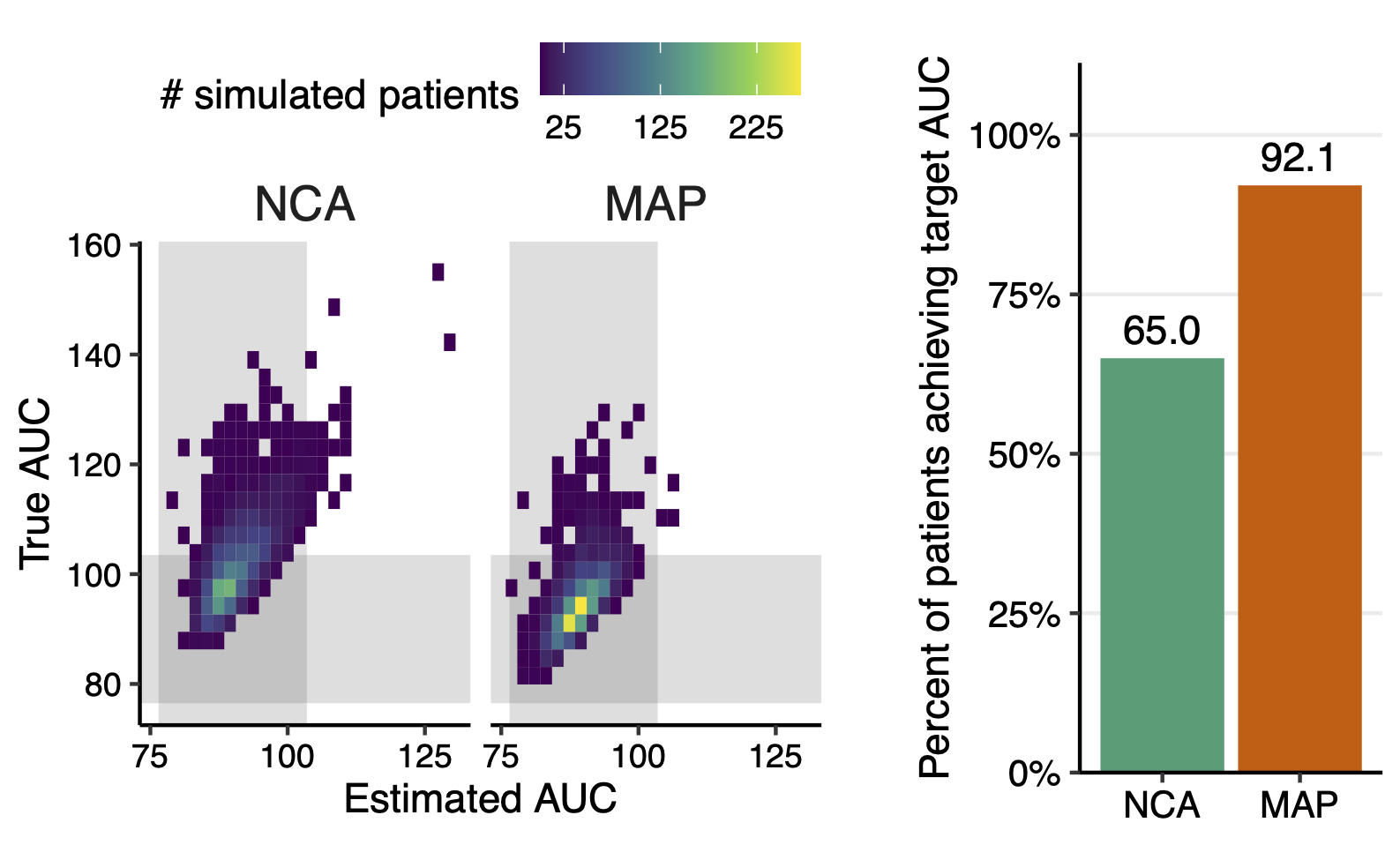The 2020 updated IDSA guidelines recommend targeting a 24-hour area under the concentration-time curve (AUC24) of 400-600 mg-h/L, replacing this recommendation with the earlier advice to target a trough of 15-20 mg/L as a surrogate marker for this AUC24. This recommendation is based in part due to growing evidence that trough correlates poorly with AUC24 (Patel et al (2011), Pai et al (2014)). Adjusting doses to target a specific AUC24 is more complex than trough-based dosing: clinicians either need to collect two precisely-timed samples and use log-linear calculations to estimate drug clearance, or need to have available Bayesian software enabling estimation of AUC24 from a single level.
An example is shown in the figure below to illustrate how AUC24 and trough exposures can vary depending on just the dosing interval. Two different regimens were simulated using the model by Thomson et al (2009) for a patient weighing 70 kg and with a creatinine clearance of 120 mL/min. Both 1500 mg Q12 hours and 1000 mg Q8 hours result in an AUC24 of 529 mg*h/L, which is within the target AUC24 range recommended by the 2020 IDSA guidelines. However, the thrice daily regimen would produce a higher trough of 15 mg/L, while the twice daily regimen would produce a trough of 12 mg/L. Given a measured trough of 12 mg/L, the clinician treating the patient on the Q8 hour regimen might consider increasing the dose to 1250 mg every 8 hours to achieve a trough of 15-20 mg/L, even though the AUC24 for this patient is already on target.
Figure 1: Comparison of two regimens with acceptable AUC24. One regimen results in an acceptable trough while the other does not.
Raising the dose to 1250 mg every 8 hours would, for this example patient, result in a trough of 15 mg/L, which is within the target trough concentration range, but would lead to an AUC24 of 660 mg*h/L, well above the guideline recommendation (Figure 2). Discordance between AUC24 and trough can ultimately have clinically significant impacts on patient outcomes, particularly with the risk of acute kidney injury in patients with an AUC > 600 mg/L*h.
Figure 2: Comparison of two regimens with acceptable troughs. One regimen results in an acceptable AUC24 while the other does not.
To understand better how common discordant AUC24 and trough estimates were, we queried a large database of adult patients doses given vancomycin, but who were not dosed using Bayesian software tools (which would have allowed clinicians to monitor both AUC24 and troughs simultaneously). This data set comprised 13,660 patients treated at 20 different hospitals and included 24,380 vancomycin serum samples. The primary objective was to examine the AUC24 estimated for each dosing interval from which a trough sample was collected and compare that to the predicted trough for that interval.
Figure 3: Correlation between AUC24 and trough. Left: shaded regions indicate the target AUC24 of 400-600 mg*h/L recommended by the IDSA and the target trough of 15-20 mg/L. Right: percentage of samples (a proxy for dose adjustments) where the trough and AUC24 would agree or disagree regarding exposure target attainment.
We found a high correlation between AUC24 and measured trough values (R2 = 83%, Figure 3), however this correlation hides part of the picture: in 29% of cases, AUC24 and trough were discordant. Or, in other words, for three out of every ten cases, the clinician would have made a different dosing decision (raise, continue, or lower) depending on if they were targeting an AUC24 of 400-600 mg-h/L versus a trough of 15-20 mg/L. While for a majority of cases, trough may be a good heuristic for AUC24, for 29% of patients, this metric risks overdosing or underdosing patients. Similar results have also been described by Pai et al (2014) and Chavada et al (2017).
Conclusion
While implementation of new dosing strategies for vancomycin can be complicated (AUC targets, Bayesian methodologies, new sampling processes, etc.) partnering with an expert in model informed precision dosing (MIPD) can greatly help ease the burden.
Learn more about how InsightRX can help with vancomycin dosing (and more!) here on our module product pages.






